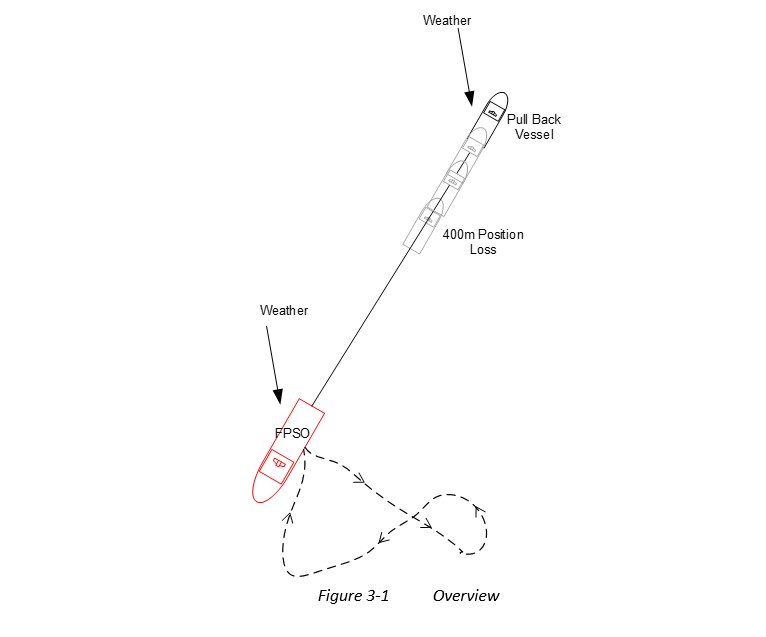Case Study – Human Factor – Training for new Vessel essential
1 Overview of the Event
A DP2 vessel was conducting Pull Back operations on an FPSO, the vessel DP Mode was set to towing at 60 tons, utilising the thrusters at 35% thrust in the forward direction. Approximately 800m of wire and polypropylene was connected to the FPSO and vessel with a pulling force on the FPSO equivalent to 40 tons.
At a certain point, without warning or indication, the propellers began to rotate with a 51 percent astern pitch, causing the vessel to approach the FPSO at a speed of 4 knots.
The senior DPO confirmed that all levers and joysticks were in the zero position. The Senior DPO then attempted to exit Towing Mode. When manual control of all thrusters was eventually achieved, the vessel was then able to return to its original Pull Back position.
The incident lasted 10 minutes and the drive and subsequent drift off totalled 400m.

2 Cause
During investigations, it was determined that the cause of this incident was the operator’s inadvertent movement of the joystick lever. Using the event’s playback log and crew interviews, it was possible to determine the underlying cause of this incident. Both DPOs who had assumed command of the watch were new to the vessel and unfamiliar with all the towing mode functions (including free surge movement during DP operations).
3 What can be concluded?
Free Surge mode is a dynamic positioning control mode that allows the DPO to move the vessel by manual IJS or lever in the direction of the surge. This mode is typically employed for operations that require the vessel to produce a large Surge [MF1] force for trenching or towing.
In Free Surge mode, the dynamic positioning control system uses the thrusters to automatically control the heading and sway of the vessel but does not attempt to control the surge motion. Instead, the surge motion is determined by the manual use of IJS or levers by the DPO and the forces acting on the vessel, including wind, waves, and currents.
Free Surge mode is useful for operations that require the vessel to be in a specific location, but do not require the vessel to be perfectly stationary. However, it is important to note that in Free Surge mode, the vessel will be more susceptible to environmental forces than in other modes. Therefore, caution is required when operating in Free Surge mode.
- The conclusion should focus on the training and competence of key DP personnel in general, as well as training specific to the DP control system on the vessel. It is assumed the crew would have read and signed off on the DP Operations Manual.
- The DPO must always be aware of how the vessel 3 axis is being controlled: Surge, Sway and Yaw. Both in relation to “over the ground” and “through the water”. This mental picture must be always present as soon as the vessel leaves the quay. When going into DP mode the best practice is to take one axis at a time: Yaw, sway and surge.
- Once in Auto Pos mode, whenever the auto control mode of one axis is deselected, the DPO must compensate that axis in manual mode. Depending on the DP functionality, for example in “towing mode” the joystick or manual lever can be used for surge when auto control surge is deselected.
- Guidance that would be relevant
- The following IMCA Guidance would be relevant
The following IMCA Guidance would be relevant to this case study:
DP Event
Published: 29 June 2023
Download: IMCA DPE 02/23
Submit a Report
The following case studies and observations have been compiled from information received by IMCA. All vessel, client, and operational data has been removed from the narrative to ensure anonymity.
Case studies are not intended as guidance on the safe conduct of operations, but rather to assist vessel managers, DP operators and DP technical crew in appropriately determining how to safely conduct their own operations. Any queries should be directed to IMCA at [email protected]. Members and non-members alike are welcome to contact IMCA if they have experienced DP events which can be shared anonymously with the DP industry.
IMCA’s store terms and conditions (https://www.imca-int.com/legal-notices/terms/) apply to all downloads from IMCA’s website, including this document.
IMCA makes every effort to ensure the accuracy and reliability of the data contained in the documents it publishes, but IMCA shall not be liable for any guidance and/or recommendation and/or statement herein contained. The information contained in this document does not fulfil or replace any individual’s or Member's legal, regulatory or other duties or obligations in respect of their operations. Individuals and Members remain solely responsible for the safe, lawful and proper conduct of their operations.
